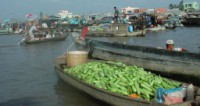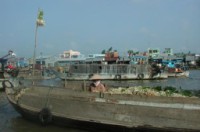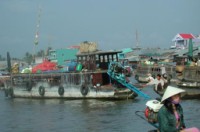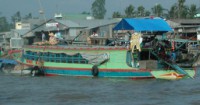After the noise and exhaust of Highway 1, the serenity of the Mekong Delta was a welcome relief. This lush region on the southern tip of Vietnam is famous for its rice production, and nothing is so green as fields of rice. Bikes, Bus and Riders all boarded the ferry to Can Tho. Originally, we were to have the option of a home stay, but given concrete floors, camp beds, and a single bathroom our tour guide made the executive decision that it would not be suitable. I was very disappointed, but made up for it later; and I will say, the hotel in which Tim lodged us instead was surely beautiful.
In fact, the Victoria at Can Tho is one of the most memorable places we stayed: besides being the first really luxurious hotel we encountered, it was my favorite, perhaps, because though built in 1998, it so much evoked the romanticism 1920s Indochine era. This is not to say this was a good time for the Vietnamese—in fact, there were any number of problems, not least of which was that Vietnam was a French colony, but the hotel, with its dark wood, chevron laid flooring, and terracotta tiles, seemed to take me back to a time when Vietnam was full of bicycles and junks, without the pollution, noise and progress—good and bad—so evident today.
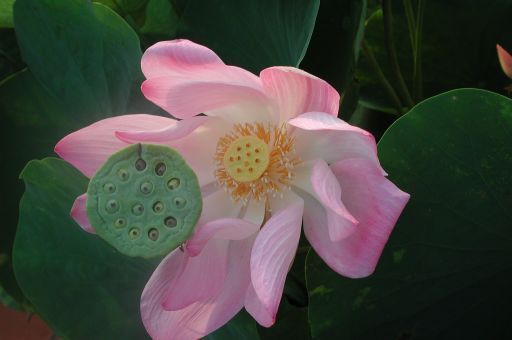
Much as I liked the hotel, I have no pix of its architecture. Despite the lack, of my favorite photos from Viet Nam, this potted lotus flower on the hotel grounds is second only to Cutting Rice
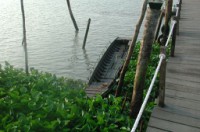
This wooden boat, a sort of skiff, was very common in Vietnam. Poorer ones are paddled (sometimes with the feet!) and those with more money mount an outboard motor to the back, but they do very well on Vietnam's extensive network of rivers and shallow streams. This picture gives a sense of the early morning light: like wholesale farmers’ markets everywhere, this one started early. We were loaded off the docks onto small boats like this, and then taken to larger, canopy covered affairs with seats in them rather like buses, plastered with ‘Victoria Cantho’ signs. (Cantho means tourist.)
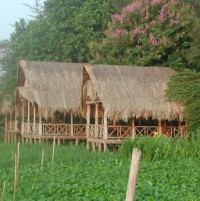
Immediately on the other side of the dock were these picturesque banana? leaf thatched huts; I never saw anything like them anywhere else, and, along with the native looms (which may indeed have been antique) displayed inside the hotel, I assume these were recreations of earlier shelters: modern Vietnamese homes, for the most part, are now stuccoed brick and even the ones made of bamboo and banana leaves usually have some modern materials, such as blue tarps, as well.
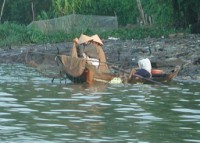
Vietnam still retains a lot of its rural culture, though of course that is disappearing very fast. If the huts are a fantasy, this is the reality. This method of net fishing, which is common, we saw a little ways down the river, shows three people in Western clothes but traditional conical hats in a wooden boat that probably could've been built any time in the last 50 or a 100 years. The polluted rivershore behind them was typical; though very clean and tidy personally, Vietnamese live amongst rivers, ditches and roadsides with an incredible amount of litter.

Though I'm sure the residents would just as soon not live in mold-stained buildings that look 50 years old (and probably are closer to 20) nevertheless this worn quality fascinated me from a photographic standpoint—over and over and over.
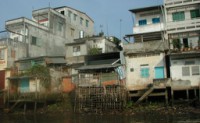
Some of the homes perching on the riverbank rest on standard beams; but others looked to grow out of forests of young tree trunks. Here the central abode, which looks like a home-made add on, is one such, with a bamboo lattice in front, perhaps to filter out river junk from collecting underneath the house. Vietnamese love flowers and gardens, and the potted plants, as seen here, are typical and common.
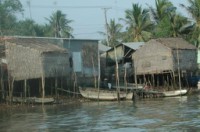
These grass huts are much more authentic, though most of the Vietnamese dwellings I saw are now stuccoed brick—what I think of as “concreteâ€.
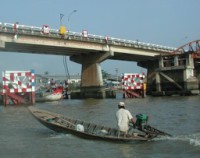
This shot nicely depicts the old—the wooden skiff—the new—the bridges above—and the inbetween—the elderly outboard motor.

I didn't have the right lenses (or proper photography skills) to take a picture that conveys just how tightly packed the floating wholesale market is. The distributors live on their boats; the wholesalers, who will take the produce back to little stands in their villages or street markets, often row by hand their little boats; some have small outboard motors to make the task a little easier.
Vietnamese, like many in the Asian world, paint eyes upon their boats, to help guide the vessels. The prows are often painted red. This boat has more colors than is common, but not unusually so.
Next time: the Viet Nam version of Notre Dame; or back to the the Highway; or return to the Vietnam index
Unless otherwise noted, text, image and objects depicted therein copyright 1996--present sylvus tarn.
Sylvus Tarn